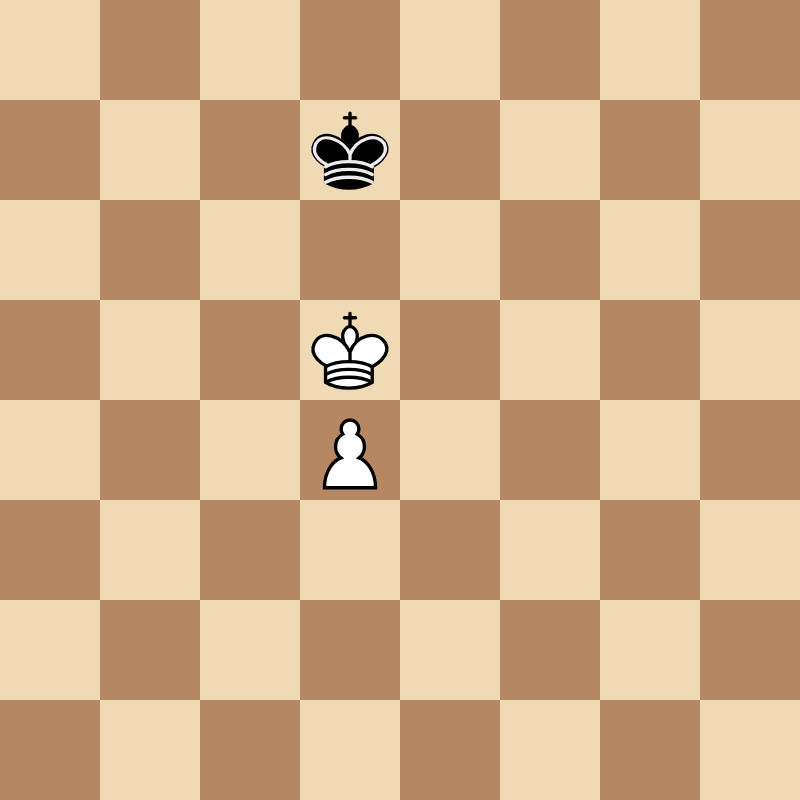The King+Pawn vs. King endgame is one of the most common chess endings, making it crucial for every chess player to understand. In this lesson, we’ll walk you through the key concepts that you’ll need to navigate this endgame..
Understanding the Square
“The square” is a quick trick to calculate whether or not the defending king is fast enough to stop your pawn from queening without your own king intervening.. Here’s how it works:
- Defining the Square: Count the number of squares from your pawn to the queening square. Draw an imaginary square with the pawn and queening square as opposite corners.
- King’s Role: If the opposing King can step into this square on his turn, it can stop the pawn from queening. If the King is too far from the square, the pawn will promote..
In this position, if it’s Black move, the game is a draw. However, if it’s White to move, the square will shrink and the pawn’s fast enough to promote.
Understanding Opposition
Opposition is a key concept in king and pawn endgames, where one king directly faces the other with an odd number of squares between them. The king that does not have the move is said to have the opposition, a crucial advantage.
Types of Opposition:
- Direct Opposition: When the kings are on the same rank, file, or diagonal, with one square between them.
- Distant Opposition: The same concept but with more than one square between the kings.
On both sides, since there’s an even amount of squares between the two kings, the side not to move will have the opposition.
Why Opposition Matters:
- The king with the opposition can force the opposing king to move away from crucial squares, allowing your king to advance and help your pawn promote.
How to Promote a Pawn vs a Lone King
Now that you know about the square, let’s discuss what happens when the opposing king is within the square.
To promote your pawn, your king needs to support the pawn by guiding it down the board. The winning method generally involves placing your king in front of your pawn. This ensures that your king can drive the opposing king away from the queening square, allowing your pawn to promote. Whether or not you’ll be able to achieve this depends on who has the opposition.
Black to move: White wins, White to move: Black holds the draw.
Key Concept: The “Red Carpet”
The “Red Carpet” occurs when your king covers all the necessary squares for your pawn to promote at the end of the board. This can be achieved if the attacking king has the opposition.
White wins with either side to move.
Rook Pawns are Usually Drawn
Rook pawns (a- and h-pawns) are a special case in king and pawn endgames. These pawns are harder to promote because there’s less space for the king to maneuver.
Drawn Endgame:
Even if the attacking king is in front of its pawn, the limited opportunity to force the defending king out of the pawn’s file (without stalemating) leads to very common rook-pawn draws. As a rule of thumb, if the defending king can occupy the squares in front of the pawn, the game will end in a draw.
The critical position: White has no way to force Black out of the queening square without stalemating.
How to Draw with a Lone King vs a Pawn and King
When defending against a king and pawn with only your king, your goal is to get in front of the pawn and maintain opposition.
Key Tips:
- Stay in front of the pawn whenever possible.
- Use opposition to force the opponent’s king to move sideways, preventing it from advancing.
- Avoid stepping aside unless you can immediately regain the opposition.
As the defending side, you should stay on the file of the pawn unless you can gain direct opposition. Here, this is not possible, so it’s alright to just step back. Another thing to note is that Black will still be controlling the square in front of the pawn, so White will never be able to gain opposition.
In this position, however, White is trying to move up the board. The only way to hold the draw is Ke6. Now, as after the pawn moves up the board, White will be unable to remove Black from the queening square (the following diagram).
White cannot remove Black from the queening square.
ChessGate
The author of this lesson has chosen to contribute anonymously.

